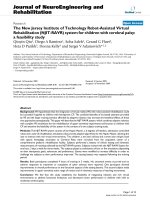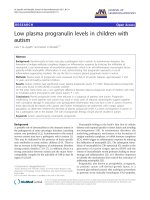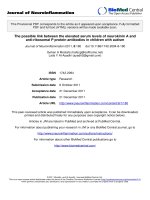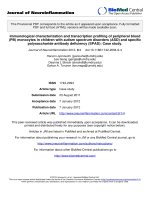Interventions Group Interventions for Children with Autism Spectrum
Bạn đang xem bản rút gọn của tài liệu. Xem và tải ngay bản đầy đủ của tài liệu tại đây (1.03 MB, 202 trang )
Group Interventions for Children
with Autism Spectrum Disorders
of related interest
Assessing and Developing Communication and Thinking Skills in People with
Autism and Communication Difficulties
A Toolkit for Parents and Professionals
Kate Silver with Autism Initiatives
ISBN 978 1 84310 352 3
Hints and Tips for Helping Children with Autism Spectrum Disorders
Useful Strategies for Home, School, and the Community
Dion E. Betts and Nancy J. Patrick
ISBN 978 1 84310 896 2
Let’s All Listen
Songs for Group Work in Settings that Include Students with Learning Difficulties and
Autism
Pat Lloyd
Foreword by Adam Ockelford
ISBN 978 1 84310 583 1
Reaching and Teaching the Child with Autism Spectrum Disorder
Using Learning Preferences and Strengths
Heather MacKenzie
ISBN 978 1 84310 623 4
Small Steps Forward
Using Games and Activities to Help Your Pre-School Child with Special Needs
Sarah Newman
ISBN 978 1 85302 643 0
Challenge Me! (TM)
Speech and Communication Cards
Amanda Elliott
Illustrated by David Kemp
ISBN 978 1 84310 946 4
Communication Issues in Autism and Asperger Syndrome
Do we speak the same language?
Olga Bogdashina
ISBN 978 1 84310 267 0
Group Interventions for Children
with Autism Spectrum Disorders
A Focus on Social Competency and Social
Skills
Albert J. Cotugno
Jessica Kingsley Publishers
London and Philadelphia
First published in 2009
by Jessica Kingsley Publishers
116 Pentonville Road
London N1 9JB, UK
and
400 Market Street, Suite 400
Philadelphia, PA 19106, USA
www.jkp.com
Copyright © Albert J. Cotugno 2009
All rights reserved. No part of this publication may be reproduced in any material form (including photocopying or
storing it in any medium by electronic means and whether or not transiently or incidentally to some other use of this
publication) without the written permission of the copyright owner except in accordance with the provisions of the
Copyright, Designs and Patents Act 1988 or under the terms of a licence issued by the Copyright Licensing Agency
Ltd, Saffron House, 6–10 Kirby Street, London EC1N 8TS. Applications for the copyright owner’s written
permission to reproduce any part of this publication should be addressed to the publisher.
Warning: The doing of an unauthorised act in relation to a copyright work may result in both a civil claim for
damages and criminal prosecution.
All pages marked ü may be photocopied for personal use with this program, but may not be reproduced for any
other purposes without the permission of the publisher.
Library of Congress Cataloging in Publication Data
A CIP catalog record for this book is available from the Library of Congress
British Library Cataloguing in Publication Data
A CIP catalogue record for this book is available from the British Library
ISBN 978 1 84310 910 5
ISBN pdf ebook 978 1 84642 951 4
Printed and bound in Great Britain by
Athenaeum Press, Gateshead, Tyne and Wear
Contents
Acknowledgements
Preface
9
11
PART I AUTISM SPECTRUM DISORDERS
1
Introduction
15
2
Definitions of Autism Spectrum Disorders (ASD)
and Pervasive Developmental Disorders (PDD)
20
3
Historical Background For ASD
27
4
Additional and Alternative Definitions for ASD
41
5
Social Development and Children with ASD
44
PART II TREATING CHILDREN WITH AUTISM
SPECTRUM DISORDERS
6
Stress and Anxiety
61
7
Attention
80
8
Flexibility, Change, and Transition
91
9
Managing and Regulating Affective and Emotional
Responses
100
10 Combining Social Competence and Social
Skill Building
104
PART III GROUP INTERVENTIONS WITH CHILDREN
WITH AUTISM SPECTRUM DISORDERS
11 A Model for Group Interventions for Children
with ASD
111
12 Forming an Understanding of the ASD Individual
128
13 Introduction to a Stage Model of Group
Development for ASD Individuals
142
14 Stages of Group Development
148
15 Roles that Individual Children May Take within
the Group
165
16 Roles that the Group Leader May Take
within the Group
175
Appendices
181
References
193
List of Figures
2.1
Pervasive Developmental Disorders (PDD) and Autism Spectrum Disorders (ASD)
22
3.1
Significant developments in the history of Autism Spectrum Disorders
29
5.1
Selected social skills to be addressed
56
6.1
Stress-Anxiety Continuum
69
6.2
Individual Profile – Stress-Anxiety Assessment
72
7.1
Developmental progression of attention
79
7.2
Flow of focused attention
79
7.3
Flow of sustained attention
83
7.4
Flow of selective attention
84
7.5
Flow of flexible attention
85
7.6
Flow of joint attention
86
7.7
Individual Profile – Attention Assessment
89
8.1
Patterns of inflexibility/rigidity
96
8.2
Individual Profile – Flexibility, Change and Transition Assessment 98
98
12.1
Social Competency and Social Skills Groups Test Information and Data Sheet
131
12.2
Social Competency and Social Skills Groups Test Initial Evaluation and
Interview Form
133
12.3
Social Competency and Social Skills Groups Areas of Interest Form
137
12.4
Social Competency and Social Skills Groups Individual Goals Form
139
12.5
Social Competency and Social Skills Groups Group Goals Form
141
15.1
Suggested individual goals for “The General”
167
15.2
Suggested individual goals for “The U.N. Observer”
170
15.3
Suggested individual goals for “The Forward Reconaissance”
172
15.4
Suggested individual goals for “The Mediator”
174
16.1
Suggested goals for the group leader as “Expert”
176
16.2
Suggested goals for the group leader as “Dictator”
178
Acknowledgements
Our doubts are traitors
And make us lose the good we oft might win
By fearing to attempt.
Measure for Measure,
William Shakespeare, 1604
Writing this book has truly been a labor of love. It was however, not
completed in a vacuum and because of that, there are many to thank. To
those friends and colleagues who provided consistent support and encouragement, I am most grateful, especially to Peter Szuch who kept me from
taking anything too seriously; to Michael Cauley for being in the right place
at the right time; to Scott McLeod whose steady leadership of YouthCare has
allowed it to thrive; and to those teachers and mentors of whom there are too
many to name.
Most importantly, this work would not be possible without the constant
support and presence of my spouse, Debra Levine, the most gifted and
talented special educator I know; my children, Rebecca, a thinker of
meaning and purpose, and David, a sensitive soul and a born teacher; and
finally, my father, who gives me loyalty, intensity, and perseverance, and my
late mother whose compassion, love of knowledge, learning, and values, live
on in the hearts of those left behind.
9
Preface
Autism Spectrum Disorders (ASD) refers to a group of developmental
disorders appearing in children soon after birth. They are characterized by
significant and pervasive impairments in critical areas of development
including language and communication skills, typical behavioral skills and
interactions, and social interactive abilities. Some children may be impaired
in only a single area while others may exhibit problems across a broad range
of development. The number of areas of impairments and the severity of the
delay in any area combine to provide differentiation of the nature of the
disorder within the individual and from individual to individual and allow
for categorization and diagnosis where appropriate. The study of ASD is a
fast growing and rapidly evolving field and this has paralleled a marked
increase in the number of individuals being diagnosed with ASD. Currently,
the Centers for Disease Control and Prevention (2007) report that in studies
of broad cohorts of eight-year-old children across the United States,
combined data indicate that 1 in 150 children are currently being diagnosed
with some form of ASD.
The intent of this book is to provide a context and a model for understanding ASD and an approach to addressing and managing some of the
prominent issues that interfere with social interactions and communications.
Part I places a frame around ASD, with an understanding of its historical
context and how and why terms are defined and used in specific ways,
followed by a discussion and understanding of the social aspects of the
disorders, including the relationship of typical social development to these
disorders. Part II addresses issues related to the description, management,
and treatment of core deficits (referred to here as key variables or processes)
as they occur in social interactions and social situations. Finally, and most importantly, Part III provides a description of a model for group interventions
with ASD individuals which is grounded within a stage-based, cognitive-developmental approach and which makes maximum use of peer interactions,
group therapeutic principles, cognitive-behavioral techniques, and direct
11
GROUP INTERVENTIONS FOR CHILDREN WITH AUTISM SPECTRUM DISORDERS
skill instruction. This approach is a peer group-based, interactive, therapeutic process aimed at developing and enhancing social interactive and social
communicative structures and skills of ASD individuals believed necessary
for growth and progress within a social world.
12
PART I
AUTISM SPECTRUM
DISORDERS (ASD)
Do not be anxious about tomorrow,
For tomorrow will be anxious for itself.
Matthew, 6:34
Part I provides a brief introduction to ASD and how it relates to the approach
described in this book. Current definitions are presented in order to understand the range of thinking (and controversy) that continues to exist and
influence the field as intervention models are sought.
Next a broad historical perspective is presented to trace and to understand the path that ASD diagnoses have traveled and how we have arrived at
our current state of understanding. Additional definitions of ASD are also
briefly presented to provide the broadest understanding of the diagnostic
issues that are currently being addressed.
Last in Part I, since ASD is primarily a social disorder for many individuals on the spectrum, an understanding of social development is considered
critical, particularly as it relates to the treatment and management of the
social deficits observed in ASD individuals. Social development as it relates
to both typical and ASD individuals is described and later considered within
the group-focused, peer-based, cognitive-developmental stage model
described in this book.
Chapter 1
Introduction
Autism Spectrum Disorders (ASD) are a group of neurologically-based
disorders which significantly affect development in social, behavioral, and
language/communication areas. ASD includes the diagnoses of Autistic
Disorder (AuD), Asperger’s Disorder (AD), and Pervasive Developmental
Disorder-Not Otherwise Specified (PDD-NOS) and are considered to be
part of the global category of Pervasive Developmental Disorders (PDD),
due to their extensive, pervasive, and debilitating effects on the particular
areas affected. At this time, the causes of these disorders are unknown and
there are no known preventions or “cures.” Categorization and often
diagnosis of ASD individuals is complicated by differences in specific
symptom clusters as manifested from individual to individual, in the range
and intensity of these symptoms, and in the degree of impairment that these
symptoms cause for the individual. Accurate and consistent diagnosis is
further complicated by ongoing controversy within the ASD field about
what specific criteria constitute a given ASD diagnosis, where the borders
and boundaries of ASD diagnoses lie, and how best to construct research and
studies to address these issues. Nevertheless, great strides have been made in
understanding these disorders and effective interventions which lessen and
diminish their intensity and improve their outcome continue to be developed
and tested. Still, developing, assessing, and implementing promising interventions continue to be a time consuming and painstaking process requiring
many years and many dedicated individuals. Yet as Wing 1991 (p.116) states:
the best way to help any socially impaired child is to recognize the social
impairment, examine for and, as far as possible, treat or alleviate any identifiable underlying cause or associated conditions, assess specific skills and
disabilities and overall level of intelligence, then use this information to
plan an individual programme.
15
GROUP INTERVENTIONS FOR CHILDREN WITH AUTISM SPECTRUM DISORDERS
Individuals with ASD exhibit a wide range of behaviors, often with significant variability from individual to individual. While impairments in social interaction, communication, and repetitive and perseverative behaviors, may
be most obvious and prominent, other behaviors may be more subtle and
variable. Individuals with ASD typically also have difficulties in one or more
of the following areas: perseverative thoughts, persistent preoccupations;
narrow, overfocused interests; high needs for routines and sameness; inflexibility and rigidity; poor anxiety management; poor perspective-taking and
theory of mind; clumsiness or poor fine or gross motor skills; sensory issues;
attention problems; or inability to read or interpret nonverbal, social cues.
In this book, specific aspects of ASD are addressed, focusing primarily
on significant impairments in social interaction, including an inability to understand and interpret nonverbal behaviors in others, a failure to develop
age-appropriate peer relationships, a lack of interest or enjoyment in social
interactions, and a lack of social or emotional reciprocity. In addition, there is
also a focus on those concerns characterized by the presence of repetitive and
stereotypic patterns of behavior, interests, or activities, including intense and
persistent preoccupations, a rigid or inflexible adherence to rituals or
routines, and repetitive, stereotypic motor mannerisms.
The approach described here targets those ASD individuals who exhibit
social impairments, but without marked cognitive or communication deficits.
In the literature, particularly the Diagnostic and Statistical Manual – Fourth
Edition (DSM IV) (American Psychiatric Association 1994), this description
of ASD is viewed as describing primarily individuals with Asperger’s
Disorder (AD). Many AD individuals may benefit from this approach, but by
definition, other individuals with disorders such as High Functioning
Autism (HFA), PDD-NOS, and AuD, may also be included when appropriate.
This book focuses on individuals with ASD who function at the higher
end of the ASD spectrum, which generally refers to those individuals with
average or better cognitive abilities, no significant communication deficits,
manageable behavior, and no significant mental illness. While this group is
broad and diagnostically complex, they share many characteristics and
behaviors that can be addressed with the program and treatment interventions described here. The common trait for those ASD individuals which
provides the primary emphasis for this book is the basic inability to relate to
and engage consistently in age-appropriate social interactions, particularly
with peers. These individuals appear to lack the basic social competence for
the development of effective and successful interpersonal relationships with
peers and significant adults. For example, many ASD individuals may be
16
INTRODUCTION
quite oblivious to the social situation they may be in, others may recognize
the social needs of the situation but not know what to do about it, while
others may recognize the needs of the situation and make attempts to engage,
but be totally lacking the specific skills necessary to effectively complete the
social exchange.
This book first considers definitions of ASD, then describes historical
and background information. This is followed by a discussion of social development in typical and ASD individuals with emphasis on key variables
known to be deficient in ASD individuals. This sets the foundation for a description of a group-based intervention program. This program places
primary focus on a stage-based model within a cognitive-developmental
framework and uses group therapy principles, cognitive-behavioral approaches, and skill-based instruction, to treat high functioning individuals
with ASD. A guiding principle in this program is characterized as a
Process/Skill approach, that is, the process or structure (referred to here in
social development as social competency) must first be in place and be
available to the individual so that subsequent skill learning (referred to here
in social development as social skills) can take place.
For all individuals, the development of social competence depends on
the interaction of inherent genetic and temperament characteristics, aspects
of biological, physiological, cognitive, neurological, behavioral, and
emotional development, and social experiences. In typical development,
social competence consists of several different aspects of social development,
including the ability to recognize and understand a social situation, the
ability to initiate a social interchange, the ability to understand its content
and move it forward, and the ability to respond to the range of stimuli
available from both other individuals involved and specific aspects of the
situation or environment (i.e., engage in and follow a discussion or play
activity in an appropriate setting). In essence, social competence is the
capacity to engage in a reciprocal process of shared experience with another
individual or individuals (Shores 1987) while communicating on many
verbal and nonverbal levels and understanding context, situation, and environment. While extremely complex in nature, this process includes the
capacity to attain and maintain developmentally appropriate levels of social
recognition and awareness, social interest and motivation, social comprehension, memory, learning, social skill development, and social-emotional
affective states (e.g., sympathy, empathy). Social competence is the result of
ever changing and evolving experiences across a wide range of development
17
GROUP INTERVENTIONS FOR CHILDREN WITH AUTISM SPECTRUM DISORDERS
affecting one’s capacities to understand and to interact with other human
beings.
While social competence relates to the ability or capacity to engage successfully in social interaction, social skills on the other hand, are the actual
tools or skills that enable the social interaction itself to proceed and to work
smoothly. Social skills are the actual ways an individual uses to initiate, to
engage, to communicate, and to respond to others when involved in an interchange. In other words, social competence is the ability and capacity to
engage in a reciprocal social interchange (consisting of the underlying
structure necessary to recognize, acknowledge, engage, and follow through
in the situation), while social skills provide the actual ways in which the individual performs in this situation (e.g., makes eye contact, says hello, asks a
question, listens and formulates a response, arranges a subsequent meeting,
says goodbye).
Some ASD individuals lack many or all aspects of social competence,
some possess few or no social skills, and many struggle with a variety and
range of combinations of social competence and social skill deficits. The
approach described here attempts to systematically assess the ASD individual’s social abilities and skills and to thoughtfully place them in a social
situation (i.e., small group, peer-based, structure based, skill-focused, and
adult-monitored situation) where the individual’s social competence and
social skills needs can be addressed. While ASD individuals may benefit from
a variety of different types of interventions (Klin and Volkmar 2000), it is
believed that the core deficit in social interaction can be best addressed by
focusing both on social competency and social skill development within a
group setting with peers and monitored as needed by adults. This setting
provides the environment for learning about and understanding the process
of reciprocal social interchange and learning the skills needed to engage
others successfully while at the same time experiencing relationships, connections, and emotional experiences as part of a therapeutic group
environment.
In this environment, related to both the individual within the group and
the group as a whole, a cognitive-developmental model is adhered to at each
point in time. Development is viewed as experiencing and learning through
stages and within each stage of development, building systematically an understanding of the individual’s own and the group’s capacities and abilities to
engage, then teaching the relevant skills to effectively and in age-appropriate
ways interact with peers in natural settings. This book will describe the
18
INTRODUCTION
group model developed which operates within a cognitive-developmental
framework and which makes use of group therapy principles, peer-based interactions, structured cognitive-behavioral techniques, and skill-based
instruction.
19
Chapter 2
Definitions of Autism
Spectrum Disorders
(ASD) and Pervasive
Developmental Disorders
(PDD)
Autism Spectrum Disorders (ASD) are considered to be neurologically-based
disorders of unknown origin which have gained the increasing attention and
interest of professionals recently. Particularly over the past decade, dramatic
increases in the incidence of ASD have been reported with most recent
estimates ranging as high as 1 in 150 (Centers for Disease Control and Prevention 2007) and as high as 1 in 210 for children with Asperger’s Disorder
(AD) (Ehlers and Gillberg 1993; Kadesjo, Gillberg, and Hagberg 1999).
Overall, prevalence reports range from 0.3 to as high as 70 per 10,000
children (Fombonne 2003) and on average, reflect a nearly 1300 percent
increase over a ten-year span (1992–2002) of children classified with ASD
who receive special education services (Center for Environmental Health,
Environmental Epidemiology Program 2005). However, ongoing controversy about the most appropriate diagnostic criteria for Pervasive Developmental Disorders (PDD), ASD, and AD and how they are applied in both
research and clinical settings, may have contributed to differences in prevalence estimates and to the application of consistent, appropriate, and valid diagnostic criteria. Other factors, such as an increased awareness in the general
public, earlier and more thorough diagnosis, increased responsibilities
20
DEFINITIONS OF AUTISM SPECTRUM DISORDERS (ASD) AND PERVASIVE DEVELOPMENTAL DISORDERS (PDD)
shifted to educational settings, an increased number of professionals in the
field, increased parental involvement, and aggressive advocacy, may also be
contributing to increased prevalence rates.
Within the Diagnostic and Statistical Manual of Mental Disorders, Fourth
Edition (DSM IV) (American Psychiatric Association 1994), the most widely
used manual for diagnostic classification, particularly within the United
States, the diagnostic category of PDD contains disorders characterized and
defined by severe, serious, and pervasive impairments in several areas of development, including reciprocal social interaction skills, language and communication skills, or the presence of restricted, stereotypic, repetitive
behavior, interests, or activities, providing sharp and marked contrast from
the appropriate development in these areas by normally developing individuals. The DSM IV category of PDD includes Autistic Disorder (AuD),
Asperger’s Disorder (AD), Pervasive Developmental Disorder-Not
Otherwise Specified (PDD-NOS), Rett’s Disorder, and Childhood
Disintegrative Disorder (CDD).
Rett’s Disorder and CDD however, are both disorders associated with
progressive loss of functioning and of skills that had previously been
attained within the first few years of life as well as with severe mental retardation. Both are low incidence, rarely seen disorders, with Rett’s Disorder
known to occur only in females. While both are of unknown origin, each
appears to have strong neurological and genetic components and the appropriateness of their placement within the PDD category remains controversial. While currently included as PDD, neither Rett’s Disorder nor CDD are
considered part of the autism spectrum.
Autism Spectrum Disorders are considered a subcategory of PDD, and
include only AuD, AD, and PDD-NOS. These three diagnoses constitute the
“autism spectrum” with AuD at one end, and including lower functioning individuals, and AS at the other end, including higher functioning individuals.
PPD-NOS appears to fall somewhere in the middle. In addition, each
diagnosis itself also appears to operate within a continuum or range of functioning with lower functioning individuals at one end and higher functioning individuals at the other end.
21
ü
Figure 2.1 Pervasive Developmental Disorders
(PDD) and Autism Spectrum Disorders (ASD)
Pervasive Developmental Disorders
Autism Spectrum Disorders (ASD)
Autistic Disorder (AuD)
Asperger’s Disorder (AD)
Rett’s Disorder
Childhood Disintegrative Disorder
Pervasive Developmental DisorderNot Otherwise Specified
22
Copyright © Albert J. Cotugno 2009
DEFINITIONS OF AUTISM SPECTRUM DISORDERS (ASD) AND PERVASIVE DEVELOPMENTAL DISORDERS (PDD)
Autistic Disorder (AuD)
Autistic Disorder is a term used to describe individuals who demonstrate
marked impairment or abnormal development in the three areas of social interaction, communication (functional and/or pragmatic), and range of activities and interests (i.e., restrictive, stereotypical, repetitive, self-destructive).
Approximately 75 percent of AuD individuals appear to function in the
mentally retarded range, while 25 percent appear to be functioning at
average or higher levels. Thus at one end of the AuD continuum would be individuals with significant social interaction problems, significant communication or language delays, and restricted, repetitive, and stereotyped patterns
and who may also experience significant, even profound cognitive, deficiencies. At the higher end of the AuD continuum would be individuals with less
significant social interaction difficulties (e.g., possibly meeting only two of
four DSM IV criteria), less severe communication delays (e.g., possibly
meeting only one of four criteria), and fewer or less intense restricted, repetitive, or stereotyped behaviors (e.g., possibly meeting only one of four
criteria), and who may not possess any delays in cognitive functioning. In
DSM IV, AuD is defined by twelve criteria, four each within the categories of
social interaction, communication, and repetitive and stereotyped patterns of
behavior, interests, and activities. To obtain a diagnosis of AuD, an individual
must meet criteria on a total of at least six items. These six criteria must
include at least two problems from the category of social impairment. Impairments in social interaction are defined by: difficulties with nonverbal
behaviors such as eye-to-eye gaze, facial expression, body postures, and
gestures to regulate social interaction; difficulties with developmentally appropriate peer relationships; an inability to spontaneously seek or share
enjoyment, interests, or achievements with other people; and problems with
social or emotional reciprocity.
These six criteria must include at least one deficiency from the category
of communication. Deficits in communication are defined by: the absence or
significant delay in the development of spoken language; significant difficulty in initiating or sustaining conversation; stereotypic, repetitive, or idiosyncratic language usage; and the absence of developmentally appropriate
spontaneous pretend or social imitative play.
Finally in meeting the minimum of six criteria necessary for a diagnosis
of AuD, at least one deficiency must be present from the category of restricted, repetitive and stereotyped patterns of behavior, interests, and activities. These deficiencies include: an intense and overwhelming focus or preoccupation with one or more stereotyped and restricted patterns of interest; an
23









